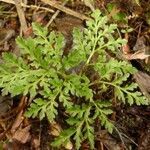Rhizome erect, 1–5 cm long; roots thick, fleshy, contractile. Fronds 5–50 cm tall, fleshy. Common stipe 1–5 cm long. Sterile lamina borne on a stipe (1–) 5–18 (–27) cm long, ternate, 3-pinnate to 3-pinnate-pinnatifid, lanceolate-deltoid to broadly ovate-deltoid, 3–22 cm long, 4–25 cm wide. Ultimate segments variable, ovate to oblong or obovate, acute to obtuse; margins entire or finely toothed. Sporophore borne on a stipe 9–22 cm long, 2–3-pinnate, standing above the sterile lamina. Sporangia brown at maturity.
Rhizome erect, stout, up to 3 cm. or more long; roots crowded, fleshy. Fronds 2-5-pinnate or dissected, fleshy, us. solitary, 5-50 cm. tall; stalks stout, basal appendages up to 5 mm. long. Sterile lamina 5-15 cm. long and broad, broadly deltoid in outline, ultimate pinnules 3-5 mm. wide. Fertile lamina us. longer and narrower; sporangia globular, crowded, sessile or subsessile, c. 1 mm. diam.

